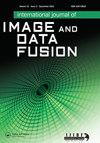Fusion and classification of multi-temporal SAR and optical imagery using convolutional neural network
IF 1.8
Q3 REMOTE SENSING
International Journal of Image and Data Fusion
Pub Date : 2021-12-22
DOI:10.1080/19479832.2021.2019133
引用次数: 9
Abstract
ABSTRACT Remote sensing image classification is difficult, especially for agricultural crops with identical phenological growth periods. In this context, multi-sensor image fusion allows a comprehensive representation of biophysical and structural information. Recently, Convolutional Neural Network (CNN)-based methods are used for several applications due to their spatial-spectral interpretability. Hence, this study explores the potential of fused multi-temporal Sentinel 1 (S1) and Sentinel 2 (S2) images for Land Use/Land Cover classification over an agricultural area in India. For classification, Bayesian optimised 2D CNN-based DL and pixel-based SVM classifiers were used. For fusion, a CNN-based siamese network with Ratio-of-Laplacian pyramid method was used for the images acquired over the entire winter cropping period. This fusion strategy leads to better interpretability of results and also found that 2D CNN-based DL classifier performed well in terms of classification accuracy for both single-month (95.14% and 96.11%) as well as multi-temporal (99.87% and 99.91%) fusion in comparison to the SVM with classification accuracy for single-month (80.02% and 81.36%) and multi-temporal fusion (95.69% and 95.84%). Results indicate better performance by Vertical-Vertical polarised fused images than Vertical-Horizontal polarised fused images. Thus, implying the need to analyse classified images obtained by DL classifiers along with the classification accuracy.基于卷积神经网络的多时相SAR与光学图像的融合与分类
遥感图像分类是一个难点,特别是对物候生长期相同的农作物进行分类。在这种情况下,多传感器图像融合允许生物物理和结构信息的全面表示。近年来,基于卷积神经网络(CNN)的方法由于其空间光谱可解释性而被广泛应用。因此,本研究探讨了融合多时相Sentinel 1 (S1)和Sentinel 2 (S2)图像在印度农业区土地利用/土地覆盖分类中的潜力。分类使用了贝叶斯优化的二维cnn分类器和基于像素的SVM分类器。在融合方面,采用基于cnn的siamese网络和拉普拉斯金字塔比例法对整个冬季种植期的图像进行融合。这种融合策略使得结果具有更好的可解释性,并且还发现基于2D cnn的深度学习分类器在单月(95.14%和96.11%)和多时间(99.87%和99.91%)融合的分类准确率与单月(80.02%和81.36%)和多时间融合(95.69%和95.84%)的SVM分类器相比都有较好的表现。结果表明,垂直-垂直极化融合图像的性能优于垂直-水平极化融合图像。因此,这意味着需要分析DL分类器获得的分类图像以及分类精度。
本文章由计算机程序翻译,如有差异,请以英文原文为准。
求助全文
约1分钟内获得全文
求助全文
来源期刊

International Journal of Image and Data Fusion
REMOTE SENSING-
CiteScore
5.00
自引率
0.00%
发文量
10
期刊介绍:
International Journal of Image and Data Fusion provides a single source of information for all aspects of image and data fusion methodologies, developments, techniques and applications. Image and data fusion techniques are important for combining the many sources of satellite, airborne and ground based imaging systems, and integrating these with other related data sets for enhanced information extraction and decision making. Image and data fusion aims at the integration of multi-sensor, multi-temporal, multi-resolution and multi-platform image data, together with geospatial data, GIS, in-situ, and other statistical data sets for improved information extraction, as well as to increase the reliability of the information. This leads to more accurate information that provides for robust operational performance, i.e. increased confidence, reduced ambiguity and improved classification enabling evidence based management. The journal welcomes original research papers, review papers, shorter letters, technical articles, book reviews and conference reports in all areas of image and data fusion including, but not limited to, the following aspects and topics: • Automatic registration/geometric aspects of fusing images with different spatial, spectral, temporal resolutions; phase information; or acquired in different modes • Pixel, feature and decision level fusion algorithms and methodologies • Data Assimilation: fusing data with models • Multi-source classification and information extraction • Integration of satellite, airborne and terrestrial sensor systems • Fusing temporal data sets for change detection studies (e.g. for Land Cover/Land Use Change studies) • Image and data mining from multi-platform, multi-source, multi-scale, multi-temporal data sets (e.g. geometric information, topological information, statistical information, etc.).
 求助内容:
求助内容: 应助结果提醒方式:
应助结果提醒方式:


